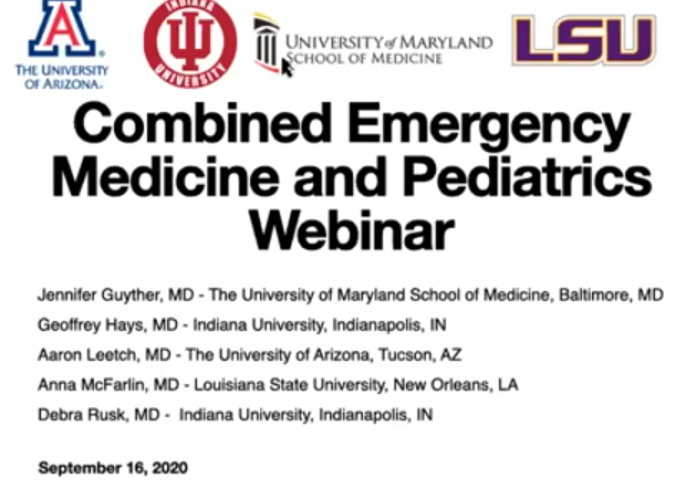EM & Peds FAQs
Pediatric emergency medicine is a wonderful field of practice, but there are several paths to reach that goal. We encourage you to explore the options and pick the one that is right for your career goals. You can start by reading an article titled “A Roadmap for the Student Pursuing a Career in Pediatric Emergency Medicine” to understand the nuances between the training pathways. Additionally, you can listen to an interview on The Undifferentiated Medical Student Podcast. You cal also listen to the most recent National EM&Peds webinar from 2022 via the EMRA website.
What are the ways I can train in Pediatric Emergency Medicine?
Your options for expert training to take care of children in the emergency department are below with the strengths and limitations listed.
- Peds-PEM (Pediatric residency followed by a pediatric emergency medicine fellowship)
- EM-PEM (Emergency medicine residency followed by a pediatric emergency medicine fellowship)
- EM & Peds (Combined emergency medicine & pediatric residency)
- EM Residency followed by Pediatric Residency or vice versa (Two separate residencies)
What are the differences between these training pathways?
| Characteristics | Peds Residency PEM Fellowship |
EM Residency |
Combined EM & Peds Residency |
| Duration of Training | 6 years | 5-6 years | 5 years |
| Training Methodology |
General pediatric residency |
EM residency with PEM fellowship |
Simultaneous EM and general pediatric residency |
| NRMP Match Cycles | 2 | 2 | 1 |
| Training Focus by Curriculum |
Research Pediatric ED |
General ED Pediatric ED |
General pediatrics General ED Critical Care |
| Primary Board Eligibility | General pediatrics | Emergency Medicine | General Pediatrics and Emergency Medicine |
| PEM Sub-Board Eligible? |
Yes | Yes | No |
| Trained to care for adults? | No | Yes | Yes |
| Clinic or hospitalist career potential? |
Yes | No | Yes |
What are the job opportunities for EM & Peds graduates?
EM & Peds-trained graduates are highly sought-after practitioners because of the breadth of knowledge and skills that they possess. EM & Peds graduates have opportunities in adult and pediatric emergency departments, pediatric clinics, pediatric hospitalist work, and global health. Additionally, EM & Peds graduates are eligible for fellowship opportunities in both pediatrics and emergency medicine. Visit our Alumni page to learn more about what our graduates have done.
Of note, Combined EM & Peds Residency graduates are eligible for General Pediatrics and the Emergency Medicine board certification. However, they are not eligible for Pediatric Emergency Medicine subspecialty board certification. This nuance only seems to matter at institutions that feel that the PEM fellowship route is the best training for their system and is variable throughout the country. We have several graduates of the EM & Peds program who work in children’s hospitals and who are on the faculty of PEM fellowships. To date, none of our graduates have completed a PEM fellowship after completing the EM & Peds residency.
How competitive are EM & Peds residency programs?
The limited number of Combined EM & Peds residency programs in the country makes the programs quite competitive. However, there are fewer applicants who show a true interest in both emergency medicine and pediatrics compared to those who choose one over the other. Therefore, we encourage potential applicants who feel that Combined EM & Peds training is right for them to consider applying to our program. The University of Arizona Combined EM & Peds residency provides a complete holistic review of all applications and does not use score cutoffs when considering applicants for interviews.
How can I best strengthen my application for an EM & Peds residency?
The first thing that we look for when reviewing an application is why you want to do both Emergency Medicine and Pediatrics. This is usually best seen in your personal statement, so take the time to explain your interests, goals, and why you will be a great emergency physician and a great pediatrician. In addition, we value the diversity that you will add to our program, your wellness in Tucson and within the residency and the clincial and academic excellence you have shown throughout your training.
All EM & Peds program directors recommend that potential applicants choose either categorical Emergency Medicine or categorical Pediatrics or both as a backup due to the limited number of Combined EM & Peds spots in the country. Because of this, we recommend strengthening your application toward whichever categorical program you choose. Just be sure you include why you want both in your application.
You can read more about our application requirements on the website below.
https://emergencymed.arizona.edu/residencies/ua-combined-em-peds/prospective-residents/apply
What rotations should I do during my 4th year to strengthen my application for an EM & Peds residency?
Most everyone will end up doing a pediatric rotation and an EM rotation. These are important to secure pediatric and emergency medicine letters of recommendation.
We would also recommend either a Pediatric ICU or Pediatric ED elective if possible. These are certainly not necessary, but both of these rotations are relevant to categorical EM and categorical Pediatric residencies and certainly relevant to EM & Peds. We offer these rotations at the University of Arizona through VSAS at the website below.
https://medicine.arizona.edu/students/student-affairs/visiting-medical-students
Please note that our visiting student slots are limited and, therefore, competitive. So, if you are not granted a spot, please do not take this as an indication of your competitiveness for the program. We just have very limited spots available to non-UA students.



